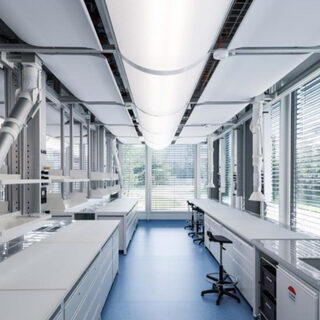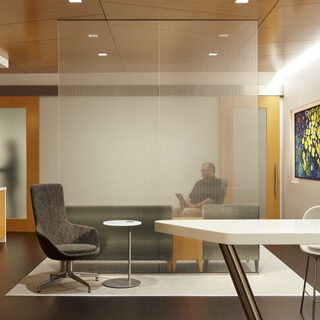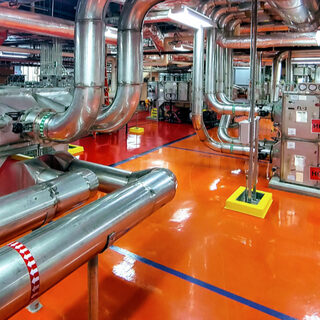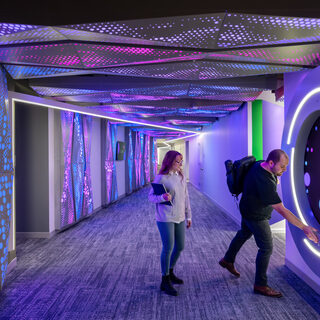Tradeline's industry reports are a must-read resource for those involved in facilities planning and management. Reports include management case studies, current and in-depth project profiles, and editorials on the latest facilities management issues.
Latest Reports
Unlocking Animal Labs’ Digital Potential
Faced with growing demand to do more with less, animal laboratory managers are looking for opportunities to drive greater efficiencies. One way forward is the use of digitalization to improve energy efficiency as well as asset and space utilization. But tight budgets, the need to improve data collection and analysis, and insufficient numbers of staff trained to operate the new systems are all holding back adoption, according to experts at Siemens Smart Infrastructure.
Space Plans for Healthcare that Help Recruit and Retain Staff
It’s no secret that many healthcare organizations are struggling to attract and keep enough staff to look after their patients. New space plans are offering solutions to the staffing challenge that increase healthcare worker satisfaction and success by making it easier for them to do their job. Not all staffing considerations are building-related, but there are many ways the building can work to help doctors, nurses, therapists, and aides do their jobs more effectively while maintaining their own physical and mental health. That balance is attractive to healthcare workers.
Management and Communication Lessons from a Stalled Lab Renovation
When it was proposed in 2019, repurposing underutilized space at the University of Georgia for an industry partner’s fermentation lab appeared to be a good deal for everyone involved. It was a win for the pharmaceutical company that wanted to contract with the university to help it develop new products and needed a fermentation lab that met, at a minimum, biosafety level 2 (BSL-2) standards. It was a plus for staff at the university’s Bioexpression and Fermentation Facility who would perform the work. It represented an advance for the university that wanted to form new industry relationships and had available space at its Athens, Ga. campus inside the Animal Health Research Center (AHRC). And it was a win for the AHRC, a 75,000-sf biocontainment facility that would host a new industry partner in addition to other laboratories performing BSL-2, animal biosafety level 2 (ABSL-2), biosafety level 3 (BSL-3), animal biosafety level 3 (ABSL-3), and animal biosafety level 3-agricultural (ABSL-3Ag) research work.
Empowering AI-Ready Research Environments
Artificial intelligence is no longer a futuristic concept; it’s a transformative force actively reshaping how research is conducted, how buildings are designed, and how energy is consumed. From self-driving labs—defined as laboratories where scientific systems can autonomously perform multiple cycles of the scientific method—to smart energy systems, AI is ushering in a new era of efficiency, collaboration, and complexity. This shift was evident in a series of think tank sessions hosted by SmithGroup’s Science & Technology, Artificial Intelligence, and Energy Advisory Board, where leaders from academia, private industry, the energy sector, design, engineering and planning explored the rapid evolution of AI and its impact on research environments. In just six months between sessions, the pace of change was striking: Half of the experts expressed openness to selective technological enhancements, an idea nearly all had rejected earlier. This growing acceptance signals a more tangible AI-driven future, though strategies around governance and energy are still emerging. The following report offers insights into how AI is transforming research ecosystems, the energy infrastructure needed to support this growth, and the challenges and opportunities ahead.
Building Next-Gen STEM Facilities for Long-Term Viability
Academic STEM facilities need the flexibility to accommodate an expanding range of disciplines and pedagogical methods while equipped with an adaptable infrastructure responsive to occupancy shifts and technology advances. Today’s projects often span the complexity spectrum, from soft spaces and graduate student workstations outside the lab to a zero-point energy (ZPE) environment for quantum physics research or an engineering lab housing a wind tunnel. While the terms “flexibility” and “adaptability” are often used interchangeably to describe the requirements of a lab building, planners at Research Facilities Design (RFD) draw a clear distinction between the two. In their context, flexibility is what occurs below the ceiling, for example, movable casework that allows a lab to accommodate new equipment or new research opportunities. Adaptability refers to what happens above the ceiling, such as robust MEP systems, well-organized ductwork and piping racks, and spare capacity at the electrical panel to support new or expanded programs in the building.




